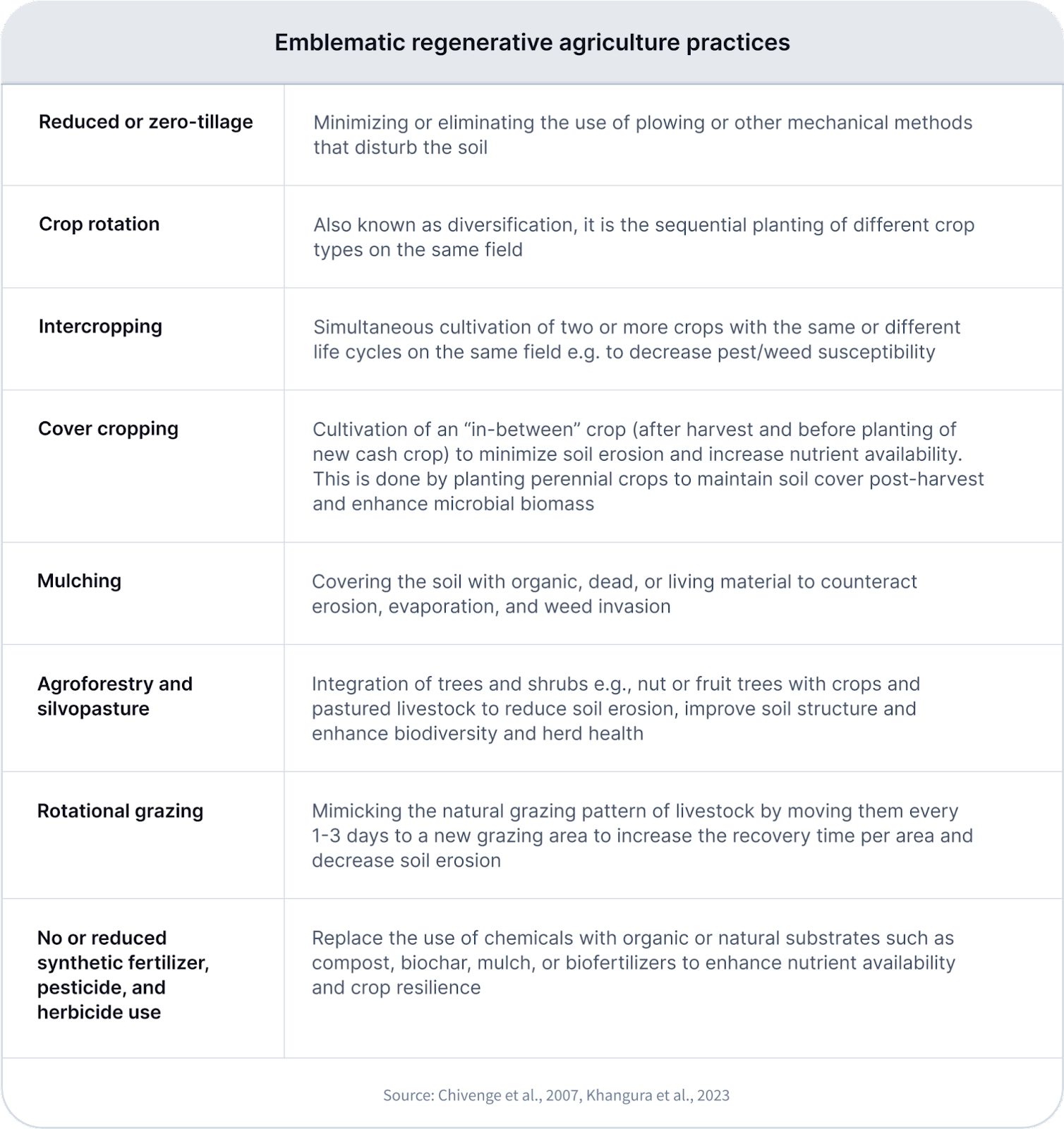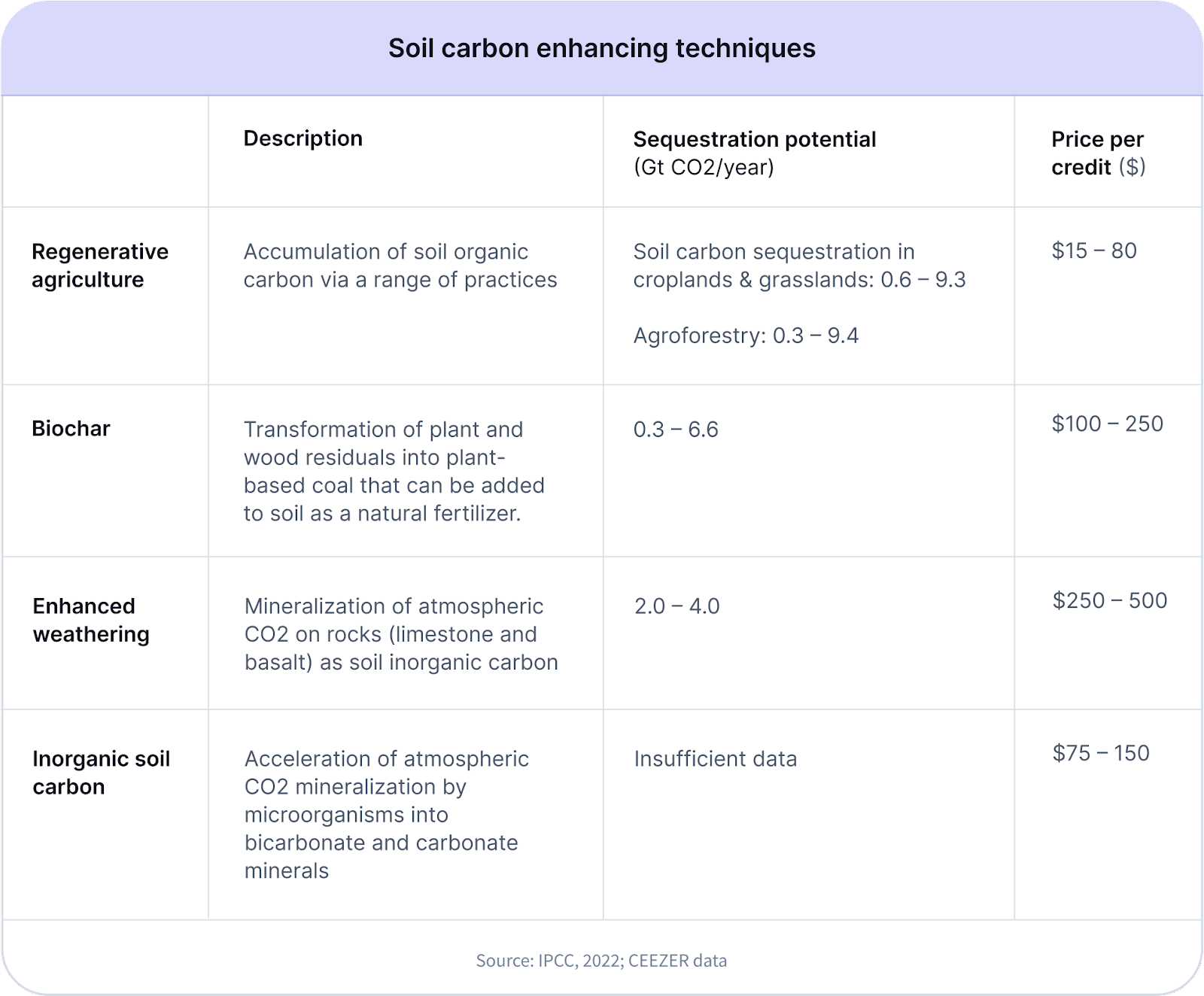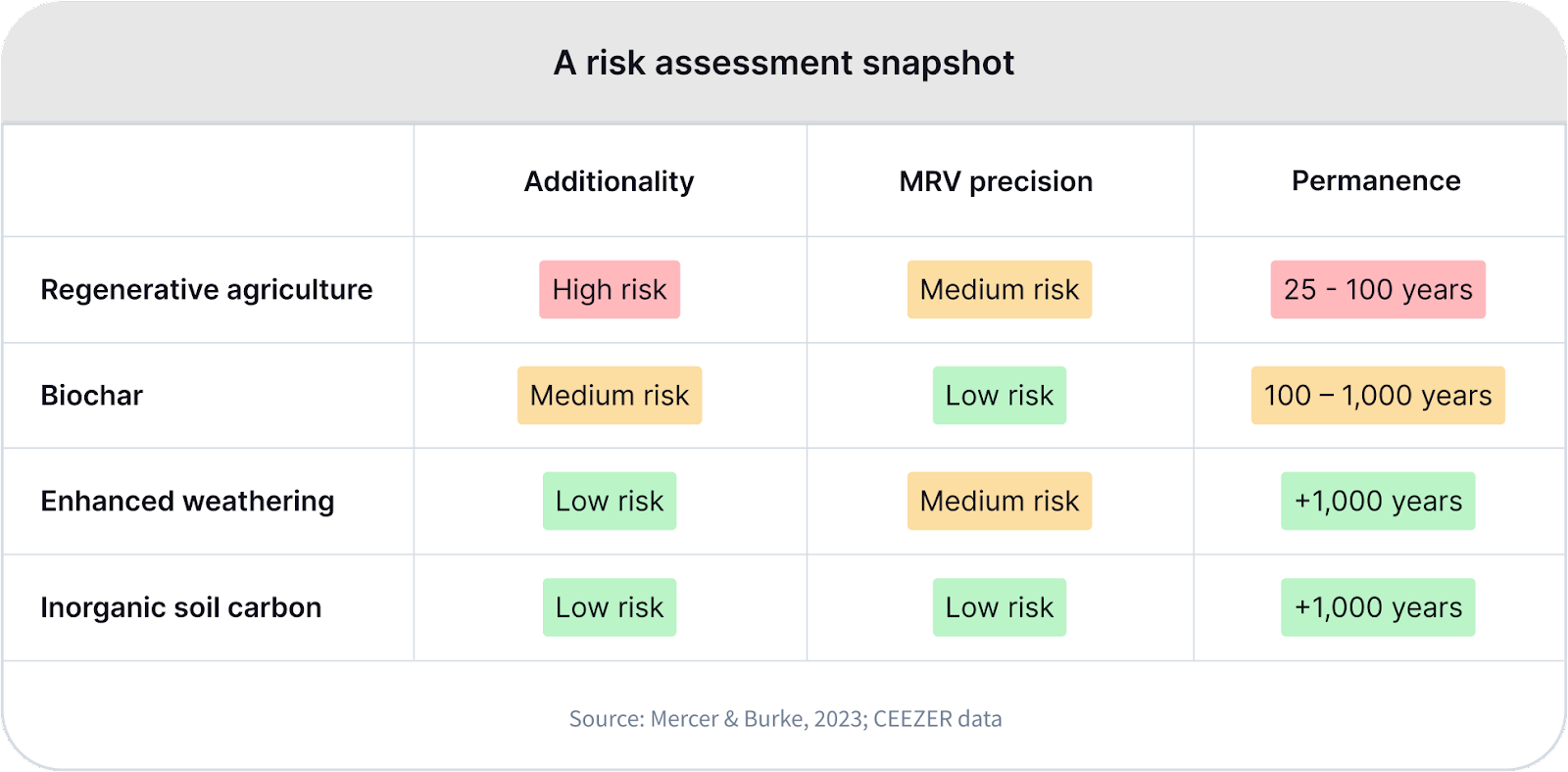Agriculture plays a dual role in the context of greenhouse gas (GHG) emissions, acting both as a source and a sink. Considering that approximately one-third (4.7 billion hectares) of the world’s land is used for agricultural purposes, how we manage this land has significant implications for addressing climate change (FAO, 2022).
Unfortunately, the current trajectory is far from ideal. Nkonya et al. (2016) reported that over the past 1,000 years, 43% of previously biologically productive land has undergone irreversible degradation. As a result, the food production system in its industrial form is currently responsible for 19–29% of total anthropogenic GHG emissions and is the primary driver for biodiversity loss (UNEP, 2021; Vermeulen et al., 2012).
With its philosophy of “feeding the soil, not the plant,” regenerative agriculture is an effective tool to fight against climate and mitigate internal GHG emissions. The voluntary carbon market (VCM) enables organizations to support regenerative farmers and steer agriculture in a more sustainable direction. At the same time, farmers are given the opportunity to boost profits by selling carbon credits obtained through the considerable ecological benefits of regenerative agriculture – a real win-win scenario.
Based on our work with larger corporations and partnerships with leading project developers in this field, CEEZER has seen that soil is increasingly important to realize relatively permanent but cost-effective carbon removal. That said, credits based on regenerative agriculture remain less understood than more traditional credit categories. Hence, it is crucial for buyers to understand the underlying mechanisms as well as the risk profile these projects have compared to other removal methodologies.
What is regenerative agriculture?
Despite widespread interest in regenerative agriculture, no widely accepted definition of the term exists. Let us start by looking at its fundamental idea first.
In 1983, agronomist Richard Hardwood described the core principles of regenerative agriculture in the following way:
- Interrelatedness of all parts of a farming system, including the farmer and farm family
- Biological balances in the system
- Need to maximize desired biological interactions while minimizing the use of materials and practices that disrupt those relationships
More concretely, regenerative agriculture can be described as a holistic approach that goes beyond organic farming by focusing on rebuilding and regenerating the soil, as well as improving the overall health and biodiversity of the farm ecosystem. This involves carefully managing land to facilitate the efficient passage of CO2 through plants and into the soil, where it is then stored and protected as soil organic carbon.
The benefits extend far beyond carbon sequestration, also bolstering food security and improving crop productivity. Additional non-climate co-benefits include improving water conservation and harvesting, as well as restoring and enhancing biodiversity. For instance, insect pollinators, threatened by industrial farming, are priceless players in the food production system when integrated into agricultural practices (Henriquez-Piskulich et al., 2021).
Changing our agricultural practices to recapture carbon in soil – How does that work?
In practice, regenerative agriculture can be implemented through a range of different ecologically-sound practices. Here is a glimpse of the most prominent ones:

Regenerative agriculture carbon credits: Avoidance or Removal? Both!
Regenerative agriculture encompasses a diverse range of methods that farmers can adopt. Depending on which aspects the project focuses on, carbon credits can be categorized as either carbon removal or avoidance:
- Carbon removal credits are generated through the increase of soil organic carbon or above- and below-ground accumulation in shrubs and trees. For instance, no-tillage practices retain carbon in the soil and reduce CO2 fluxes. These credits fall into Oxford Category 4, indicating removal with short-term storage.
- Carbon avoidance credits arise from the mitigation of various emissions across the farm, including reduced fossil fuel combustion, livestock enteric fermentation and manure deposition, biomass burnings, and nitrogen fertilizer usage. This avoidance component can be sizable and highly impactful given the significant emissions caused by traditional agricultural practices. These credits fall under the classification of Oxford Category 1, denoting avoidance credits without storage potential.
Essential components defining the quality of carbon credits from regenerative agriculture projects
As with all other project types, not all regenerative agriculture carbon credits are equal. When evaluating the effectiveness and impact of a regenerative agriculture project, CEEZER evaluates four critical aspects that need to be carefully considered: additionality, permanence, measurement strategies, and leakage risk.
1. Additionality
For regenerative agriculture projects to qualify as carbon credits, they must demonstrate that they have generated carbon avoidance or removal that would not have happened without the incentive from the VCM. Assessing additionality involves considering three key dimensions: financial, political, and environmental (Dipu et al., 2022).
- Financial additionality looks into the project’s need for carbon finance to be viable. Farmers often experience financial barriers to transition to regenerative agriculture due to the time-consuming nature of the transition, uncertainty risk, and initial investment costs. For instance, the absence of fertilizers and herbicides can initially put plants under pressure to find sufficient nutrients and resist pests, which can lead to an initial yield decline.
- Political additionality takes a closer look at the host country’s regulatory environment. A country investing heavily in the agricultural transition through subsidies could present limits to political additionality. For instance, the European Union is implementing a new policy framework to facilitate the regenerative agriculture transition in the context of the Farm to Fork strategy. As countries start to elaborate and implement such strategies, additionality will need to be assessed on a case-by-case basis.
- Environmental additionality entails generating measurable climate and environmental impact. Making sure that the project activities are implemented on existing agricultural land (cropland or grassland) with no former conversion from pastures or forests to agricultural land guarantees a positive climate impact.
2. Permanence
Permanence indicates how long the climate impact of a project or activity is expected to last. It is difficult to provide a universal indicator for the permanence of regenerative agriculture projects considering the risks of natural disasters or reversion to conventional methods. As such, project developers and standards propose different methods to assess the risk of reversal. Trinity Agtech, for example, assesses that certain regenerative agriculture practices stop carbon accumulation in the soil after 20 years when implemented systematically, following the IPCC 2019 guidelines on carbon footprinting. Klim encourages farmers to adopt regenerative agriculture practices over multiple years by distributing carbon finance revenues. If farmers decide to leave the program and stop using regenerative practices before 5 years, they will not receive the outstanding income.
Dr. Dennis Melzer, Klim’s R&D Officer explains: “The transition process involves not only the application of regenerative management techniques but also requires a rethinking of a farmer’s management habits and mindset. Klim was built to guide farmers through the whole transformation process and motivates them to permanently adopt climate- and soil-friendly ways of farming. The project thus stimulates farmers to deeply internalize the benefits of a permanent transition and to change their farming habits permanently. This decreases the likelihood of a reversion to the pre-transition status quo.”
3. Measurement strategies
The choice of measurement technique for assessing baseline scenarios and soil organic carbon development is crucial in evaluating quality. There are no one-size-fits-all solutions for increasing soil carbon, as what works in one location may not be effective elsewhere. Therefore, real-world measurements through soil sampling followed by lab analysis are the most accurate method to validate sequestered carbon. However, such techniques can be costly and time-consuming. This leads many projects to opt for modeling methods, which can introduce result uncertainty (McDonald et al., 2021). Statistical modeling is used to infer soil carbon developments using theoretical data and simplified ecological models adjusted to empirical observations. Incorporating farm-specific data points (such as soil type, climate, and land use) strengthens the accuracy of the model to predict potential changes in carbon stock over time. For instance, carbon-crediting program Trinity AgTech uses a combined sampling-modeling approach, taking soil sample information and processing it statistically to reduce the uncertainty of both methods.
4. Leakage
Leakage refers to the emissions that are displaced instead of avoided. Transitioning away from conventional farming can require an adaptation period for the soil to restore and a subsequent decrease in crop yields. When yield decreases too drastically, we might encounter leakage issues if agricultural activities in an area outside the project boundary are initialized or intensified. To control for this leakage, most methodologies require the monitoring of crop productivity and resume credit issuance if it drops below a certain threshold. Other leakage sources include livestock displacement out of the certified project area or the application of organic fertilizers not originally applied in the baseline scenario. Not all projects integrate these leakage risks thoroughly. Trinity AgTech, however, calculates a certain initial yield decrease into the GHG calculations and deducts it from the number of issued credits.
How does regenerative agriculture compare to other project types applied on agricultural land?
Beyond regenerative agriculture, several alternative methods exist to harness the ecological potential of the soil. CEEZER collaborates with project developers who explore the application of biochar as a soil amendment, the use of enhanced rock weathering, or the introduction of microorganisms. These techniques can also be employed simultaneously. Integrating biochar with regenerative agriculture practices increases the soil's capacity to absorb CO2. The table below offers a comparison of these four techniques.

Let's delve deeper into the comparison of these approaches. The following table presents an overview of the risks associated with additionality, monitoring, reporting, and verification (MRV) precision, and permanence in the four project types. It is essential to highlight that the risk assessment within the project types is a simplified process built for comparison purposes. Designating a project as "high risk" does not automatically justify its exclusion from a carbon credit portfolio. The risk classifications should therefore not be interpreted as indicative of significant absolute risks.

Navigating the regenerative agriculture projects with CEEZER
Similar to other nature-based projects, regenerative agriculture initiatives present limited permanence in comparison to more durable carbon removal approaches such as biochar or enhanced weathering. However, in the current VCM landscape, only a few removal technologies are ready for large-scale deployment, positioning soil sequestration as one of the most viable and readily available solutions at our disposal. Therefore, soil sequestration offers valuable time to foster the development and implementation of more permanent removal methods. Given this perspective, incorporating such projects in your carbon credit portfolio is highly recommended, given the affordable price point and broader positive social and biodiversity impacts these interventions yield.
Besides carbon credit purchases to support beyond value chain mitigation, regenerative agriculture can also be utilized to mitigate emissions directly within a company’s value chain. As emphasized before, the agriculture industry contributes significantly to GHG emissions, yet there are numerous opportunities for the implementation of agricultural practices that reduce, avoid, or remove emissions. Corporations will have to play a major role in decarbonizing the food production system as they often rely, directly or indirectly, on this sector. To decarbonize these supply chains, companies can incorporate emission reduction or removal projects themselves, a process called insetting. To learn more about credible insetting interventions see our article called “make is not always better than buy – challenges with relying on carbon insetting”.
Merely undertaking regenerative agriculture practices is not enough to claim credible carbon credits. Rigorous measurement, reporting, and verification are crucial to the quality of soil carbon credits. Considering the challenges associated with accurately assessing the amount of soil organic carbon, due diligence by a third-party such as CEEZER is crucial to mitigate overcrediting risks. A project’s robustness must be guaranteed through clear calculations, well-defined methodologies and monitoring processes, and conservative buffer pools. CEEZER only collaborates with dynamic project developers who adhere to such principles, ensuring credibility and reducing material risks in a buyer's carbon credit portfolio.
Regenerative agriculture project developers featured on CEEZER
The intersection of VCM and regenerative agriculture has become increasingly important in the face of global climate change. CEEZER is paving new paths to facilitate direct trade between project developers and ambitious organizations that want to take climate action. To help support the transition towards regenerative agriculture both in Europe and the Global South, CEEZER has forged partnerships with four prominent organizations in this space:
- Klim is a Germany-based AgriTech startup that combines nature-based solutions with innovative technology and scientific research. Klim developed a digital platform specifically for regenerative agriculture. It provides farmers with access to the knowledge and financial resources they need to make the transition toward regenerative practices. Companies that partner with Klim have the opportunity to support regenerative agriculture within or outside their own supply chains.
- Trinity AgTech is a British carbon-crediting program specializing in carbon reductions and removals through regenerative agriculture practices. Farmers can track, improve and report their agricultural practices through the mobile application “Sandy” and monetize the implementation of more sustainable practices. Predictive AI technology is a core part of their scalable and thorough GHG calculation process.
- Climate Farmers is on a mission to build the infrastructure to scale regenerative agriculture in Europe, connect regenerative farmers, and help them generate carbon credits. It has developed a robust methodology aligned with the ISO 14064-2:2019 standard, audited by TÜV Nord.
- Varaha allows buyers to support smallholder farmers and rural communities across South Asia and Africa to transition to regenerative agriculture and secure their livelihoods. Applied practices are validated via remote sensing and carbon reduction and removals are calculated via an in-house developed proprietary Carbon Quantification Tool based on biogeochemical modeling including localized parameters.
If you are interested in partnering with CEEZER as a project developer or learning more about regenerative agriculture and purchasing carbon credits from these projects as a buyer, please get in touch with us or book a demo today.

.jpg)



